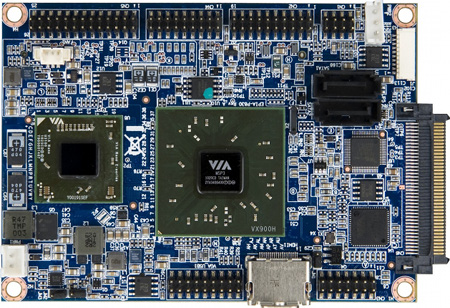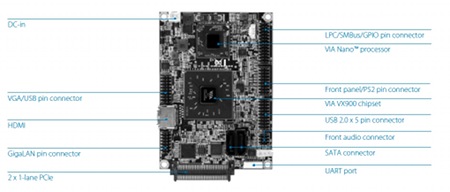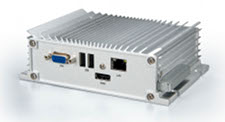Pico-ITX board has optional PCI Express expansion
Dec 15, 2010 — by LinuxDevices Staff — from the LinuxDevices Archive — 6 viewsVia Technologies announced a Pico-ITX board featuring PCI Express expansion and an embedded-oriented Nano E-series CPU. The Epia-P830 offers gigabit Ethernet, two SATA ports, and support for HDMI, VGA, and LVDS displays, the company says.
Employing Via's 3.9 x 2.8 inch (10 x 7.2cm) Pico-ITX standard, the evolutionary Epia-P830 has a layout that's almost identical to the Epia-P820 introduced last January and the Epia-P720 introduced in September 2009. However, the device (pictured below) features upgrades to its processor and supporting chipset, as well as a new PCI Express expansion option.

Via's Epia-P830
(Click to enlarge)
Regarding the CPU side of things, the board gets the 1.2GHz U3300 member of the Nano E-series processor family Via announced earlier this year. Said to have idle power consumption of just 100mW, this 64-bit CPU provides virtualization capabilities and support for Intel's SSE4 instruction set extensions, according to Via.
The Epia-P830 also moves from the earlier VX855 core-logic chip to the VX900 Via announced in March. Touted for its ability to provide 1080p video playback "without incurring a heavy CPU load," the 31 x 31mm chip accelerates H.264, MPEG-4/AVC, MPEG-2, VC-1, WMV-HD, AVS, Blu-ray, and "advanced browser streamed video technologies," Via says.
According to Via, the VX900's ChromotionHD 2.0 video engine is also said to provide motion compensation, transform, de-blocking, and AVS support. Integrated display capabilities include a dedicated CRT interface, an LVVDS transmitter, a multiplexed display interface for DisplayPort and HDMI, and a 12-bit digital video output port (DVP) for an external HMDI/LVDS/DVI transmitter.

Headers on Via's Epia-P830
(Click to enlarge)
Via leverages these capabilities on the Epia-P830 by providing an HDMI port on the board's coastline, along with pin headers for both VGA and LVDS. As shown above, there are other headers carrying USB, serial, PS/2, and audio signals, and the board also includes two SATA ports (the Epia-P820's IDE connector appears to have been dropped, however).
The Epia-P830 ships with a separate carrier board (the P830-A) that snaps firmly onto its headers, preserving access to the resident HDMI port. As pictured below, this device adds real-world VGA and gigabit Ethernet ports, along with two Type A USB 2.0 connectors, according to Via.

Epia-P830 with I/O carrier board attached
Optionally, Via provides a second carrier board that snaps onto the side of the Epia-P830, taking advantage of the device's available PCI Express expansion (2 x 1-lane). At the cost of increasing overall footprint by an unspecified amount, this add-on (below) delivers two Mini PCI Express expansion slots, "for a wealth of 3G and wireless connectivity options.)

Epia-P830 with I/O and Mini PCI Express boards
(Click to enlarge)
Though Via didn't mention the fact, we'd guess the Epia-P830 is — without the Mini PCI Express expansion, at least — physically compatible with an enclosure that was touted as turning the earlier Epia-P820 into a complete, compact "industrial-class" PC. One side of the Amos-3001, pictured below left, provides access to the Pico-ITX board's coastline, while the other side (below right) adds two more USB 2.0 ports, audio I/O, a GPIO port, and dual serial ports.


Via's Amos-3001 (optional expansion chassis shown on right)
(Click either to enlarge)
According to Via, the Amos-3001 has room internally for an IDE-interfaced flash drive. Alternatively, an add-on expansion chassis (pictured above right) provides room for a 2.5-inch SATA hard disk drive. Without the expansion chassis, the Amos-3001 measures just 5.9 x 4.25 x 1.81 inches (15 x 10.8 x 4.6cm), making it 20 percent more compact than the previously released Amos-3000, the company says.
Specifications listed for the Epia-P830 by Via include:
- Processor — 1.2GHz Nano E-series U3300
- Chipset — VX900
- Memory — 1 x DDR2 socket for up to 4GB memory
- Display/video — HDMI, VGA, or LVDS support with MPEG-2/4, WMV9, and H.264 video acceleration up to 1080p
- Storage — 2 x SATA connectors
- Expansion — PCI Express (2 x 1-lane)
- Networking — 1 x Via VT6130 gigabit Ethernet controller
- Onboard I/O pin connectors:
- 1 x USB, supporting 5 USB 2.0 ports
- 1 x LPC
- 1 x SMBus
- 1 x front panel
- 1 x PS/2
- 1 x single-channel LVDS
- 1 x audio for line-in, line-out, and mic-in
- 1 x DIO (4GPI+4GPO)
- 2 x UART
- 2 x SATA
- DC power input
- Back-panel I/O (via carrier board):
- 1 x HDMI port
- 1 x VGA port
- 1 x gigabit Ethernet jack
- 2 x USB 2.0 ports
- System monitoring — Wake-on LAN, keyboard power-on, timer power-on, system power management, AC power failure recovery, watchdog timer
- Operating temperature — 32 to 140 deg. F (0 to 60 deg. C)
- Dimensions — 3.9 x 2.8 inches (10 x 7.2cm); Pico-ITX format
Further information
According to Via, the Epia-P830 runs Linux, Windows 7, Windows CE, Windows XP Embedded, and Windows XP. Pricing and availability were not cited, but further information and a datasheet are accessible from the Epia P-830 product page.
Information on the enclosure mentioned in this story may be found on the Amos-3001 product page.
This article was originally published on LinuxDevices.com and has been donated to the open source community by QuinStreet Inc. Please visit LinuxToday.com for up-to-date news and articles about Linux and open source.